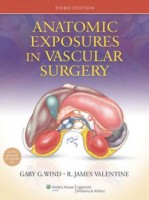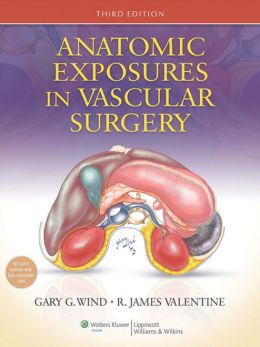 Authors: Gary G. Wind, MD, FACS and R. James Valentine, MD, FACS
Authors: Gary G. Wind, MD, FACS and R. James Valentine, MD, FACS
Contributors: Forearm Fasciotomy: Jeffrey A. Marchessault, MD; Vascular Exposure of the Lumbar Spine: David Whittaker, MD, FACS and Leo Daab, MD.
Publisher: Wolters Kluwer | Lippincott Williams & Wilkins – 587 pages
This text comes with access to complete and fully searchable contents online plus other features, to purchasers. Simply go to http://solution.lww.com, enter you access code from the scratch-off label on the inside front cover, and follow the instructions to activate your access.
Book Review by Nano Khilnani
This is an extremely useful book mainly because it is just loaded with numerous, detailed full-color and black-and-white illustrations of different parts of the human body, with particular emphasis on blood vessels – arteries, veins and nerves that supply blood containing oxygen and life-sustaining nutrients. In some cases, the illustration is mainly black-and-white but has a full-color section to provide focus on the subject covered in that part of the chapter.
The quality and clarity of the drawings are strikingly impressive. The captions accompanying each illustration provide additional information for even better understanding of the anatomy and physiology of the parts depicted. Surgical precautions are also provided in the captions.
As a random example, Figure 1-16 on page 38 of chapter 2 – Vertebral Arteries – in Part I – Extracranial Circulation of the Head and Neck – shows the nerves of the mandibles (jaws) in the human head. The black-and-white illustration of the inside of the face provides a full-color, three-dimensional depiction of the right mandible along with the nerves.
The caption reads: The ramus mandibularis branch of the facial nerve runs below the edge of the mandible and is prone to injury during carotid endarterectomy. The carotid pair of arteries is the chief duo of vessels that supply blood to the head through the neck. An endarterectomy of the carotid artery is the removal of the inner layer of this artery when it has thickened (due to various causes) and poses danger to the patient.
A critical point to note about why this book is valuable to blood-vessel (vascular) surgeons and those working to be qualified in this field is that one of the authors, Dr. Gary G. Wind, is not only a skilled in this type of surgery but is also an able and experienced illustrator. In this valuable volume, he shows what he actually sees in the operating room. He is skilled in the use of a microcomputer to create multi-dimensional anatomical images.
What sets this book apart from other specialized anatomy texts? We quote Dr. Charles Rob, a professor of surgery, who writes in his Foreword to the book:
“In a standard illustration, it appears that the vertebral artery travels only a short distance before it enters a foramen in the transverse process of the sixth cervical vertebra. A surgeon who has operated on this artery at this point knows that there is a length of several centimeters before it enters the bony foramen. This book is filled with similar useful information, which has been uncovered by Dr. Wind’s special anatomical reconstructions.”
A second important point to take note of about this excellent text is that it is written in clear and concise language. Naturally, it is assumed that the specialists who use this book are familiar with the medical terminology used in it.
This book of nearly 600 pages has six main parts with a total of 19 chapters and an Appendix. Those six parts are:
• Circulation of the Head and Neck
• Vessels of the Chest
• Vessels of the Upper Extremity
• Vessels of the Abdomen
• Vessels of the Lower Extremity
• Vascular Variation
Each chapter is well organized with important topics and subtopics containing detailed descriptions and discussions; drawings on almost every page and a list of References at the end for further exploration and study.
A short list of atlases and books with illustrations on the various parts of the human body, particularly on its circulatory system, is provided in the Appendix at the end of this book. Some of these are general texts, others are cross-sectional atlases and still others are area-specific anatomies, along with the surgical techniques required for specialized work.
In summary, this is not only an important but a necessary book to have for the vascular surgeon. It is also critical to teachers of blood-vessel anatomy. It provides clear visual anatomic relationships among all blood vessels necessary for an understanding of vascular patterns in all areas of the body. The two surgeons who have authored this book – Gary G. Wind and R. James Valentine – have done a marvelous job.
Gary G. Wind, M.D., F.A.C.S. is professor of surgery at the Department of Surgery in the Uniformed Services University of the Health Sciences and Director of Art and Education at www.Versalius.com in Bethesda, Maryland.
R. James Valentine, M.D., F.A.C.S. is professor and chairman of the Division of Vascular and Endovascular Surgery and executive vice chairman at the Department of Surgery, and Alvin Baldwin Jr. chair in surgery at the University of Texas Southwestern Medical Center in Dallas, Texas.







